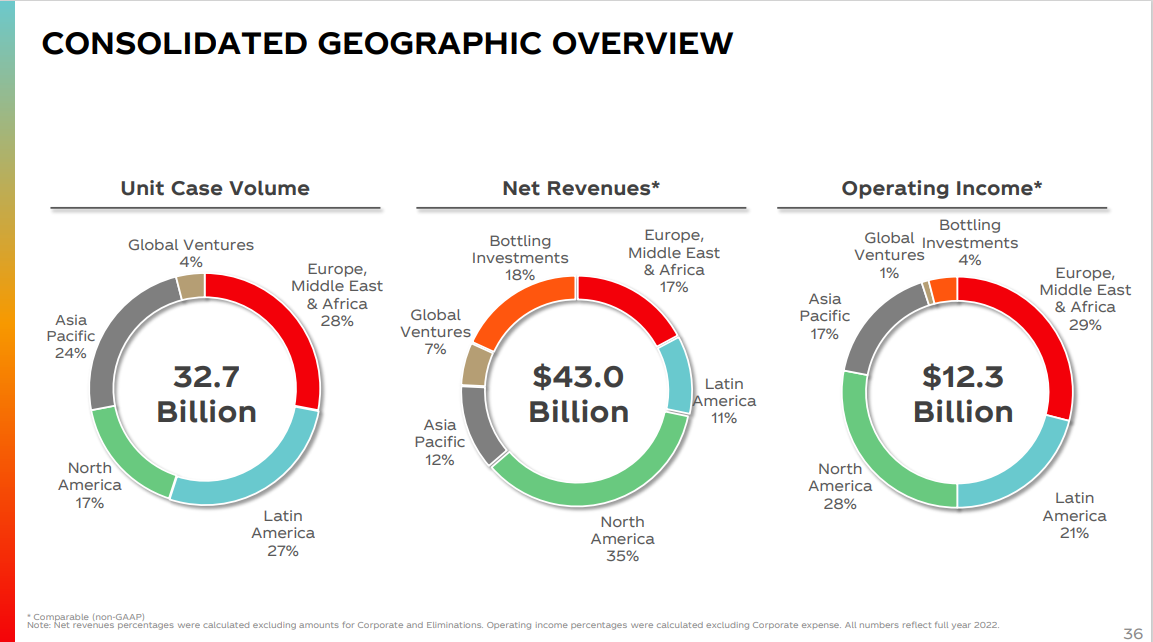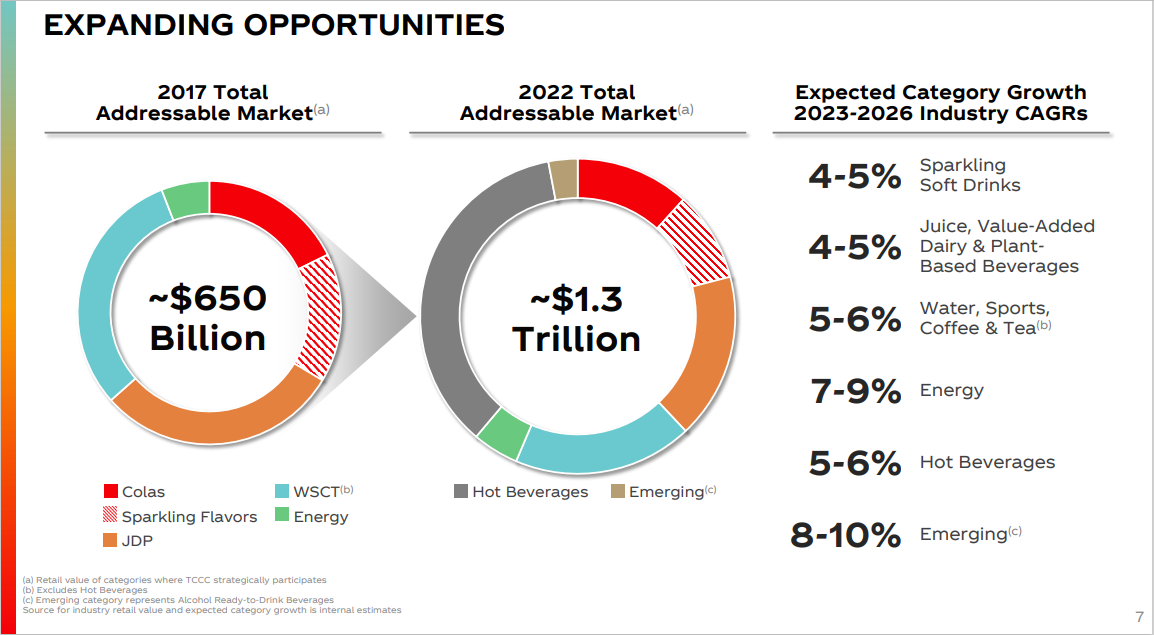Updated on September 19th, 2023 by Bob Ciura
Investors looking for the best-in-class dividend growth stocks should consider the Dividend Kings. These are stocks that have raised their dividends for at least 50 consecutive years. It is no easy task raising a dividend for over five decades, which explains why there are just 50 Dividend Kings.
You can see all 50 Dividend Kings here.
In addition, we created a downloadable list of all 50 Dividend Kings, along with important financial metrics like dividend yields, price-to-earnings ratios, and more. You can download your copy of the Dividend Kings list by clicking on the link below:
Coca-Cola (KO) is a time-tested Dividend King. It has raised its dividend for 61 consecutive years. This is an extremely impressive history of consistent dividend increases, even in difficult operating environments. Coca-Cola benefits from global competitive advantages and a recession-resistant business model.
Investors can expect the company to continue increasing its dividend for many years. This article will discuss Coca-Cola’s recent earnings, future growth potential, and expected returns.
Business Overview
Coca-Cola was founded in 1892. Today, it is the world’s largest non-alcoholic beverage company. It owns or licenses more than 500 non-alcoholic beverages, including both sparkling and still beverages.
It now sells products in more than 200 countries around the world and has 20 brands that each generate $1 billion or more in annual sales. Its brands account for about 2 billion servings of beverages worldwide every day, producing more than $45 billion in annual revenue.
The sparkling beverage portfolio includes the flagship Coca-Cola brand, as well as other soda brands like Diet Coke, Sprite, Fanta, and more. The still beverage portfolio includes water, juices, and ready-to-drink teas, such as Dasani, Minute Maid, Vitamin Water, and Honest Tea.

Source: Investor Presentation
Coca-Cola dominates sparkling soft drinks, but the company is attempting to maintain and even improve this dominant position with product extensions of existing popular brands, including reduced and zero-sugar versions of brands like Sprite and Fanta.
This is a challenging time for Coca-Cola. Sales of soda are slowing down in developed markets like the U.S., where soda consumption has steadily declined for years.
Declining soda consumption is a significant challenge for the company. While Coca-Cola’s total volumes certainly still rely upon sparkling beverages such as soda, the company has gone to great lengths in recent years to diversify away from its core products, understanding that the long-term growth prospect for sparkling beverages isn’t particularly inspiring.
Coca-Cola has acquired multiple still beverage brands in recent years to revitalize its future growth.
Growth Prospects
In an effort to return to growth, Coca-Cola has invested heavily outside of soda in areas like juices, teas, dairy, and water, to appeal to changing consumer preferences. Despite headwinds from declining soft drink consumption, we continue to see Coca-Cola as having a favorable long-term growth outlook.
One reason we like the stock is that it competes in an industry that continues to grow globally in excess of the rate of broad economic growth. This leads to strong levels of overall growth in the industry, which Coca-Cola has certainly been capitalizing on in recent years.
In addition, the ready-to-drink category is sold through highly-diversified channels and continues to have mid-single-digit projected growth rates for Coca-Cola and the industry. This is particularly true for still beverages like milk, tea, and water. Coca-Cola’s years-old strategy to diversify away from sparkling beverages is due to this, and it is undoubtedly bearing fruit.
Coca-Cola also continues to acquire brands in order to grow, including its acquisition of Costa, a coffee brand based in the U.K.
This was certainly an out-of-the-box buy for a sparkling beverage company, but Coca-Cola is doing what it takes to secure its future growth.
Finally, while Coca-Cola is the largest beverage company in the world, there continues to be ample room for additional growth.

Source: Investor Presentation
The market potential for Coca-Cola’s portfolio of beverages is massive, especially in developing and emerging markets. This should provide the company with a long runway for growth in the coming years.
In the meantime, the company continues to execute with strong quarterly results. Revenue beat estimates by $250 million at $12 billion, which was a 6.2% gain from the comparable period a year ago. Adjusted earnings-per-share came to 78 cents, which was six cents ahead of expectations.
Organic revenue gained nicely, adding 11% during the quarter. Latin America led the way at +25%, while EMEA was up 9%, and North America rose 9% as well. The company guided organic revenue growth of 8% to 9% for the year and adjusted earnings-per-share growth of 9% to 11%.
Competitive Advantages & Recession Performance
Coca-Cola enjoys two distinct competitive advantages, which are its strong brand and global scale. According to Forbes, Coca-Cola is the sixth-most valuable brand in the world. The Coca-Cola brand is reportedly worth $64.4 billion.
In addition, Coca-Cola has an unparalleled distribution network. It has the largest beverage distribution system in the world. Of the roughly 60 billion beverages consumed around the world every day, about 2 billion come from Coca-Cola.
These advantages allow Coca-Cola to remain highly profitable, even during recessions. The company held up very well during the Great Recession:
- 2007 earnings-per-share of $1.29
- 2008 earnings-per-share of $1.51 (17% increase)
- 2009 earnings-per-share of $1.47 (3% decline)
- 2010 earnings-per-share of $1.75 (19% increase)
Not only did Coca-Cola survive the Great Recession, but it also thrived. Coca-Cola grew earnings-per-share by 36% from 2007 to 2010. This shows the durability and strength of Coca-Cola’s business model. The company’s dividend also appears very safe.
Based on our projected earnings for the year and the current dividend-per-share run rate, the payout ratio stands at a rather comfortable 69%.
Valuation & Expected Returns
Adjusted earnings-per-share for Coca-Cola is expected to reach $2.65 per share in 2023. Coca-Cola trades for a price-to-earnings ratio of 22.0 at its current price levels.
This is slightly below our fair multiple of 23 times earnings, which takes into account the stock’s historical valuations as well as future growth estimates. Accordingly, we expect a rising P/E multiple to add 0.9% to annual returns over the next five years.
In addition, we expect annual EPS growth of 6%, while Coca-Cola stock has a 3.1% dividend yield. We expect total annualized returns of ~10.0%.
These are rather alluring total return projections during the current highly uncertain environment, considering they are coming from such a trustworthy company as Coca-Cola. Therefore, Coca-Cola stock receives a buy recommendation.
Final Thoughts
Coca-Cola has a long and established track record of delivering steady dividends along with annual dividend increases, even during recessions and other challenging periods. We fully expect the company to continue delivering relatively resilient results during the ongoing macroeconomic turmoil and even come out from this phase stronger than ever. The company has multiple growth catalysts and a dominant global position in the beverages industry to support it.
The stock appears to be slightly under valued, which might suggest it’s a good opportunity to consider allocating capital to the stock. Coca-Cola should also continue to pay its dividend comfortably, currently offering a solid yield above 3%. And, it should have little trouble raising the dividend each year.
Overall, Coca-Cola can be an attractive holding for income-focused investors.
The following articles contain stocks with very long dividend or corporate histories, ripe for selection for dividend growth investors:
Thanks for reading this article. Please send any feedback, corrections, or questions to [email protected].















